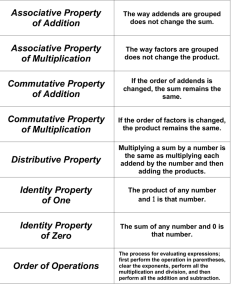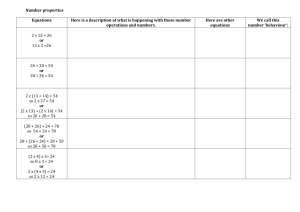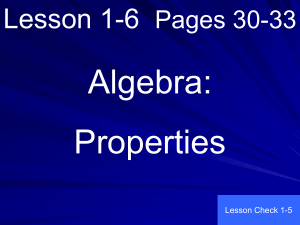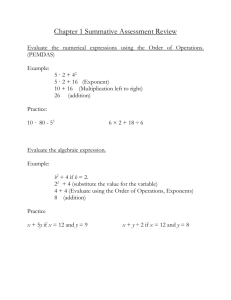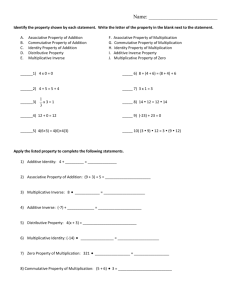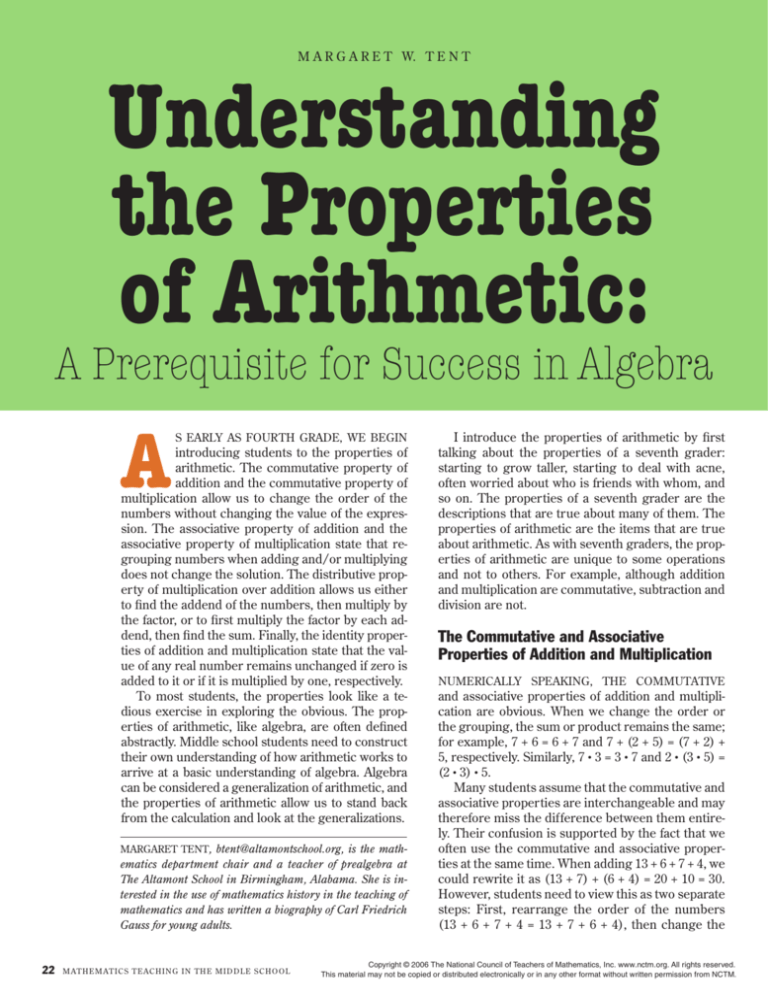
M a r g a r e t W. T e n t
Understanding
the Properties
of Arithmetic:
A Prerequisite for Success in Algebra
A
s early as fourth grade, we begin
introducing students to the properties of
arithmetic. The commutative property of
addition and the commutative property of
multiplication allow us to change the order of the
numbers without changing the value of the expression. The associative property of addition and the
associative property of multiplication state that regrouping numbers when adding and/or multiplying
does not change the solution. The distributive property of multiplication over addition allows us either
to find the addend of the numbers, then multiply by
the factor, or to first multiply the factor by each addend, then find the sum. Finally, the identity properties of addition and multiplication state that the value of any real number remains unchanged if zero is
added to it or if it is multiplied by one, respectively.
To most students, the properties look like a tedious exercise in exploring the obvious. The properties of arithmetic, like algebra, are often defined
abstractly. Middle school students need to construct
their own understanding of how arithmetic works to
arrive at a basic understanding of algebra. Algebra
can be considered a generalization of arithmetic, and
the properties of arithmetic allow us to stand back
from the calculation and look at the generalizations.
Margaret Tent, btent@altamontschool.org, is the math-
ematics department chair and a teacher of prealgebra at
The Altamont School in Birmingham, Alabama. She is interested in the use of mathematics history in the teaching of
mathematics and has written a biography of Carl Friedrich
Gauss for young adults.
22
M AT HEMATICS TEACHING IN THE MIDDLE SCHOOL
I introduce the properties of arithmetic by first
talking about the properties of a seventh grader:
starting to grow taller, starting to deal with acne,
often worried about who is friends with whom, and
so on. The properties of a seventh grader are the
descriptions that are true about many of them. The
properties of arithmetic are the items that are true
about arithmetic. As with seventh graders, the properties of arithmetic are unique to some operations
and not to others. For example, although addition
and multiplication are commutative, subtraction and
division are not.
The Commutative and Associative
Properties of Addition and Multiplication
Numerically speaking, the commutative
and associative properties of addition and multiplication are obvious. When we change the order or
the grouping, the sum or product remains the same;
for example, 7 + 6 = 6 + 7 and 7 + (2 + 5) = (7 + 2) +
5, respectively. Similarly, 7 • 3 = 3 • 7 and 2 • (3 • 5) =
(2 • 3) • 5.
Many students assume that the commutative and
associative properties are interchangeable and may
therefore miss the difference between them entirely. Their confusion is supported by the fact that we
often use the commutative and associative properties at the same time. When adding 13 + 6 + 7 + 4, we
could rewrite it as (13 + 7) + (6 + 4) = 20 + 10 = 30.
However, students need to view this as two separate
steps: First, rearrange the order of the numbers
(13 + 6 + 7 + 4 = 13 + 7 + 6 + 4), then change the
Copyright © 2006 The National Council of Teachers of Mathematics, Inc. www.nctm.org. All rights reserved.
This material may not be copied or distributed electronically or in any other format without written permission from NCTM.
grouping to (13 + 7) + (6 + 4). On the other hand,
we could start by changing the grouping, then the
order, and the grouping again: 13 + 6 + 7 + 4 = 13 +
6 + (7 + 4) = 13 + (7 + 4) + 6 = (13 + 7) + (4 + 6). In
other words, first we use one property, then we use
the other.
I give my students pictorial images for these
properties. when we use the commutative property, we put a term or number or variable on a
wagon and move it (see fig. 1). I draw that wagon
every time we use the commutative property, and
students like picturing a wagon moving the numbers around. when the associative property is discussed in my classroom, it involves holding hands.
In the expression 7 + (5 + 9), the 5 and 9 are holding
hands, and they are excluding the 7. If we rewrite
it as (7 + 5) + 9, now the 7 and 5 are holding hands
and the 9 is being excluded. As we deal with each
expression, I encourage the students to consider
whether it is a question of numbers holding hands
or of putting a number or variable on a wagon and
moving it.
factoring can prove useful in combination with
the associative property of multiplication. How can
we multiply 3 • 14 in our heads? we can start by saying 3 • 14 = 3 • (2 • 7). Then we can use the associative property: 3 • (2 • 7) = (3 • 2) • 7 = 6 • 7 = 42. we
could do the same thing with 18 • 4: 18 • 4 = (9 • 2) •
4 = 9 • (2 • 4) = 9 • 8 = 72. A thirteen-year-old can see
the utility in using the associative property to help
with arithmetic.
The associative and identity properties of addition can be used to add numbers with opposite
7+5=5+7
we transport the 7 to the other side of the 5 by
putting it on the wagon and moving it.
Fig. 1 A model for the commutative property of addition
signs: (–8) + 14 = (–8) + (8 + 6). with the associative property, we can then regroup the terms as
[(–8) + 8] + 6 = 0 + 6 = 6. The only caveat is choosing the partition of the number that is opposite of (–8),
allowing us to end up with the identity property of
addition: 0 + n = n, where n is any real number. If we
changed (–8) + 14 to (–8) + 5 + 9, it would be no help.
An important thing to remember about the commutative and associative properties is that both division and subtraction are neither commutative nor
associative. for example,
7 ÷ 6 ≠ 6 ÷ 7,
2 5 5 2
÷ ≠ ÷ ,
3 6 6 3
and the expression 7 ÷ 5 ÷ 2 does not have the same
3
3
value as 7 ÷ (5 ÷ 2).
the order
4 •In
5 division,
= 4 5 + changing
.
4 reciprocal
4
of the fractions gives the
of the original
problem’s answer. In the example above, 5/6 ÷ 2/3
is equal to the
of 2 the original problem,
reciprocal
2
2/3 ÷ 5.6. 3 5 + = 3 • 5 + 3 • = 15 + 2 = 17.
3
3
If we attempt to use the commutative or associative properties with subtraction, we run into similar
2 3 17
3 • 5 = • = 17
3 1 3
vOL. 12, NO. 1 . AuGuST 2006
23
2
2
2
2
3 5 + = 3 • 5 + 3 • = 15 + 2 = 17.
5 + = 3 • 5 + 3 • = 15 + 2 = 17. 3
3
2 3 17
3
3 • 5 = • = 17 3
3
7 ÷36 ≠ 6 ÷ 7,
5 =5+
3 1 3
4
4
2 5 5 2
÷ ≠ ÷ ,
2 3 17
2 3 17
6 6 3
3 • 5 = • = 17
3
3
3 • 5 = • = 17
3 1 3
3
5 =5+
3 1 3
difficulties; for example, 7 – 5 ≠ 45 – 7 and
The Distributive Property
4 3 – 15– 5. ≠ 3
4
– (1
3
3 – 5). The results are clearly different. As happens
of Multiplication over Addition
4•5 = 4 5+ .
3
3
3 4 3 so4often,
a consideration
of what does not fit the rule
5 =5+
3
5 =5+
4
4 as what5 does
can be just as instructive
It is both easy and dangerous to misuse the
2 If
. fit the rule.
4
4
3•5 ,
4
we change all subtraction to addition of the opposite
distributive property in algebra. Therefore, I teach it
3
2
2 the subtrahend3 and all division to multiplication
in several ways when I am still working at the arith3 5 + = 33• 5 + 3 • of
= 15 + 2 = 17. 5 .
3 5 .
3by the reciprocal 4of the divisor, then
2 the commutametic level. If we need to multiply 7 • 99, we could
3•5 ,
2
4
tive and associative properties will 3apply. Doing
rewrite that expression as 7(100 – 1), and then dis5 this
3
helps many students learn to simplify expressions
tribute: 7(100 – 1) = 7 • 100 – 7 • 1 = 700 – 7 = 693. A
2 3 17
2
2
•
•
involving
subtraction
frequent error in using the distributive property is
3 5 =
= 17
3 • 5 , and division correctly.
2
3 • 53 , 1 3
7 ÷ 6 ≠ 6 ÷ 7,
3
forgetting to multiply the factor (the 7 in this case)
5
3
3
x
=
9
,
3
5 5 2well as the first term
by the second term2(the
4
÷ ≠1) as
÷ ,
3
6
6 3
3
3
(the 100). If we were distributing
candy bars to all
2
25 = 5 +
5
students in the class and stopped after the first child,
3
5 4
4
3
4 9
x = 9, 4 3
3
there would be cries of3“Unfair!”
student wants
•
x= • ,
4
3Every
3 4
3 1
4 • 5 = 4 5 +700 .– 1 is not equal to
a candy bar. The expression
3
4
4
3
7(100 – 1). When we multiply 7 • 9 9, we get the same
3
5 .
x = 9,
4
3
4
9
x = 9, 4
7
÷
6
≠
6
÷
7
,
4
answer that we get for 7(100 – 1) = 700 – 7 = 693.
•
x= • ,
4
3 4
3 1
5 2 by a mixed number
Multiplying
a2whole
2 ÷ 5number
3
3
≠ 2÷= 15
, 2 = 17.
•5+ 3•
3
5
+
=
3
5
=
5
+
is another useful
prop3 6 63of 3the+distributive
2
4 3
4 9
3 application
4
4
4 3
43 •95 ,
•
• ,
x
=
erty in arithmetic:
•
x = • ,3
3 4
3 1
+
+
3 4
3 1
3
3
3
3
5 =+5 +
4 • 52 =34 17
5+ .
4
4
3 • 5 4= • =417
2
3 4 23
5
3 1 3
•
•
4
5
=
=
23
3
3
3
Some students do not immediately see that
4 1one.
4
3 have
3 5 of them, and then
5 =we
5 + also have 3/4 of another
We
5 =5+
4
4
2
2
4
4
3 5 + = 35•35 =
+ 35 •+ 3= 15 + 2 = 17.
Fig. 2 A model
illustrating assumed addition for a mixed
3 4 number
23
3
3 7 ÷46 ≠ 6 ÷
347,
4 • 5 3= • = 323
x = 9,
3
4 • 54 =1 4 45 + = 4 • 5 + 4 • = 20 + 3 = 23
4
4
4
4
27 ÷56(see
≠ 65 ÷fig.
72, 2). They may also
but a picture may help
÷ ≠ ÷ ,
3 4 23
have trouble accepting
33 6517the
3 4 23
4 • 5 = • = 23
35 2 65=5that
3 distributive prop2
4 9
3 •2
4 • 5 = 4 • 3 = 23
4 4 •15 34= 4 5 + 3 = 4 • 5 + 4 • 3 = 20 + 3 = 23
÷ multiplying
≠4•. ÷ =,17 mixed numbers
erty
really
works
with
3
1
3
4 1 • 4x = • ,
•
3 6 6 3
3 4
3 1
4
4
4 4 5 = 20
but again drawing pictures may help (see fig. 3).
3
3
Using the distributive
makes
4 • 5 property
= 4 25 + sometimes
.
3
3
3
3
3
3
34 • 5 = 4 5 + = 4 • 5 + 4 • = 20 + 3 = 23
433 •=55 +, 43fractions
3 12
the
multiplication
of
improper
easier.
For
5
= 4 5 + = 4 • 5 + 4 • = 20
+
3
=
23
•
•
4
4
4
4 5 4= 4 35 +4 .
4 5 = 20 4 • = = 3
4
4
example,
4
4
4 4
3
3
5 =5+
2
2
4
4
3 12
4 • 5 = 20
3 5 + = 3 • 5 + 32 • = 15 + 2 = 17.
4 • 5 = 20
4 • = = 3 20 + 3 = 23
5 .2
3
3
2
4 4
3 5 + = 3 • 5 + 34 • = 15 + 2 = 17.
3 our solution
3 by doing the multipliIn class, we check
3 12
3 12
•
4
=
=
3
cation the traditional way:
2 3 217
20 + 3 = 23
4 • 4 •=5 3 ==43• 23 = 23
4 4
•
3 • 5 3=
= 17
4 44 1 4
3 3x•135= 917
3,
2
3 • 5 4= •3 = 17
3 1 3
20 + 3 = 23
20 +33= 23
3
3
The distributive property
4 533 = 52states
4+ 39 that we should get
4 • 5 = 4 5 + = 4 • 5 + 4 • = 20 + 3 = 23
•
• ,
x
=
5
4
4
4
4
43 we do.
3
the same answer both
and
3 54ways,
= 533+ 1
Some students have4 a hard
4 time distinguishing
between
the
associative
and
the
distributive proper3
4 • 5 = 20
.9, see parentheses, it
ties. Many assume that3 5xif4=they
34 5 3 . 3 property is being
must mean that the 5distributive
=5+
3 12
used, but this is not always
4 4 the
4 case. For example,
4• = = 3
24 9
7(8 + 4) = 7 • 8 + 7 • 44is 3an
application
of the distribu4 4
•5
3
,
•
x =2
, is not. The second
33• •4)
tive property; however,
3 43 7(8
1
•5 ,
expression does not imply3that we should multiply
20 + 3 = 23
3 4 23
the 7 by both the 48• and
5 =the2• 4. The
= 23 commutative and
4 applied to change the
51 be
Fig. 3 A model illustrating the distributive property for a whole number times a
associative properties4 can
3
3 2the3distributive property
mixed number
order and grouping, but
5 5= 35 +
4 3
3
3 4
4 • 5 = 4 5 + =34 • 5 + 4 • = 20 + 3 = 23
x
=
9
,
4
4
4
43
24 M AT HEMATICS TEACHING IN THE MIDDLE SCHOOL
x = 9,
4
3
3
4 •• 5 3 = 4 5 + 3 .
2 4 5 4 = 4 52+ 4 .
3 5 + = 3 4• 5 + 3• =415
+ 2 = 17.
3
3
2
2
3 5 + 2 = 3 •• 5 + 3 •• 2 = 15 + 2 = 17.
3 5 + 3 = 32 5 +33 17
3 = 15 + 2 = 17.
3The
3 • 5 expression
does not apply.
= • 3 = 177 • 8 • 7 • 4 is not
3 7 1• (83• 4). How can a student
the same as 7 • 8 • 4 or
2 distributive
3 17
tell the difference? The
property always
3 •• 5 2 = 3 •• 17 = 17
3
5
=
involves both multiplication
addition or subtrac3= 17
3 3 1 3and
15 +3
53 =
tion. The multiplication
4 must4be one quantity times
a sum or a difference or an implied sum, as in
3
3
5 3 =5+ 3
5 4 =35 + 4
45 . 4
4
•
If we multiply 7 8 by saying
7(5 + 3), then we can
3
5 3.
distribute and get 35 + 215 =4256.
. When we multiplied 7
3 • 54 ,
• 99, we rewrote 99 as (100 – 1).When we multiplied
3
2
3 •• 5 2 ,
3 523 ,
5 3
3
we rewrote
2
52
3 53
x =3 9,
4
as a sum before we distributed. The distributive
3
property of multiplication
3 x = over
9, addition means ex4
3
4 x = 49,• 9the multiplication to
actly that: We can distribute
• 4x =
,
3 4
3 1
each addend.
Another mistake that
4 3 students
4 9 often make with the
4 • 3 x = 4 • 9,
properties is trying to
or asso• 1commutative
,
3 •apply
4 x = 3the
4
3 1 involving both addiciative property to an3 expression
3
3
5 When
= 5 + I ask students to write
tion and multiplication.
4
4
an explanation of the properties and to show their
3
3 an example like this:
work, several students
3
5 3give
= 5 +me
5
=
5
+
•
•
3 5 + 6 = 3 6 + 5. They4 need 4to see that the commu4
4
tative property of multiplication
3 4 23 and the commutative
•
•
4 5are= in fact=two
23 separate properproperty of addition
4 1 4
ties. If they did the actual arithmetic, they would see
3 4 23
that 15 + 6 is not equal
+ =5.23
The same difficulty
• 23
4 •• 5 3 =to418
4
5
= 323
3 the
3 4 = 1 • 4properties.
can arise
4
1
4
•5+
•
4 • 5with
= 4 5 +associative
=
4
4
= 20 + 3The
= 23distrib4
4 other hand,
4 works only when
on the
utive property,
we have either
or subtraction
along with
addition
3
3
5+ 3
3 =only
4 •• 5 3 = 4and
4 •• 5 +when
4 •• 3 =the
20 +multiplication
3 = 23
multiplication
4 5 4 = 4 5 +then
=
4
5
+
4
=
20
+
3
=
23
4 4 • 5 = 20 4
4 over
4 addition 4or subtractionnot
the
is distributed
when the addition is distributed (how would you do
43• 5 I=12
20
that?) over multiplication.
picked
up on those errors
4 •4 • 5= = 20= 3
by asking my students4 to 4articulate in writing their
understanding of the properties.
3 12
4 •• 3 = 12 = 3
4204+=3 4= 23
=3
Identity Properties4of 4Addition and
Multiplication
20 + 3 = 23
20 + 3 = 23
In solving equations, we can use the
identity properties of both addition and multiplication (x + 0 = x and x • 1 = x). The identity property is closely tied to opposites and
reciprocals and, therefore, to the numbers 0
and 1.
When we solve an equation such as x + 7 =
(–3), we want to find the value for x. We want to
have x + 0 equal a number since with the iden-
4
4
3
5 .
43
5 .
4
2
3•5 ,
tity property of addition, x +320 = x. We need to replace
•5 ,
the 7 with 0. How can we3get
30? If we add the opposite
of 7 to 7, we get 0; thus, in 2the equation x + 7 + (–7) =
(–3) + (–7), and then x + 05 3= (–10) or x = (–10).
2
To solve an equation like
5
3
3
x = 9,
43
x = 9,
we want to find the value
4 of one x. Multiplying both
sides of the equation4by3the reciprocal
of 3/4, we get
4 9
•
x= • ,
34 43
34 19
•
x= • ,
3 4
3 1
•
or 1 x = 12. Applying the identity property of multi3 x =312.
plication, 1 • x = x, we have
5 =5+
43
43
5 =5+
Summary
4
4
Algebra can be viewed as a generalization
3 properties
4 23
of arithmetic, and4 •the
•
5 =
= 23of arithmetic can
43 14With
4 addition or multiplished light on this view.
23
4 • 5 =the• order
= 23(the commutative
cation, we can change
4 1 4
property) of
or variables
that we are
numbers
3 the
3
3
•5
•5+ 4•
= 4 5 + = 4and
= 20 + 3will
= 23be the
adding4 or
multiplying,
the
result
43 43
43
same. We
the grouping of numbers or
4 • 5 can
= 4change
5 + 4 = 4 • 5 + 4 • 4 = 20 + 3 = 23
4 associative
variables (the
property) that we are add4 • 5the
= 20result will remain the
ing or multiplying, and
same. To multiply a number
by a sum, we can either
4 • 5 = 20
(1) add first and then multiply or (2) multiply the
3 12
number by each addend,
4 • = then
= 3 add those products
4
4
3 12
(the distributive property).
4• = = 3
The identity properties
4 4are used to solve equa20to
+ 3find
= 23 the value of 1x, we
tions. When we want
multiply the coefficient of x by its reciprocal. To get
20 + 3 = 23
x + 0, we add the opposite of the addend since the
sum of any number plus its opposite is 0.
Understanding the properties of arithmetic lays
the foundation for students to understand algebra as a
generalization of arithmetic. Mastering these concepts
in arithmetic helps students succeed in algebra. l
Show Me the Math:
Learning through Representation
By focusing on assessment across the grades,
NCTM wants to help teachers, school leaders, and
teacher educators understand what representation
is and to expand their thinking about the role of
representation in teaching and learning mathematics. For more information and additional resources
on the NCTM Focus of the Year, visit www.nctm
.org/focus.
V O L . 1 2 , N O . 1 . A ug u st 2 0 0 6
25

